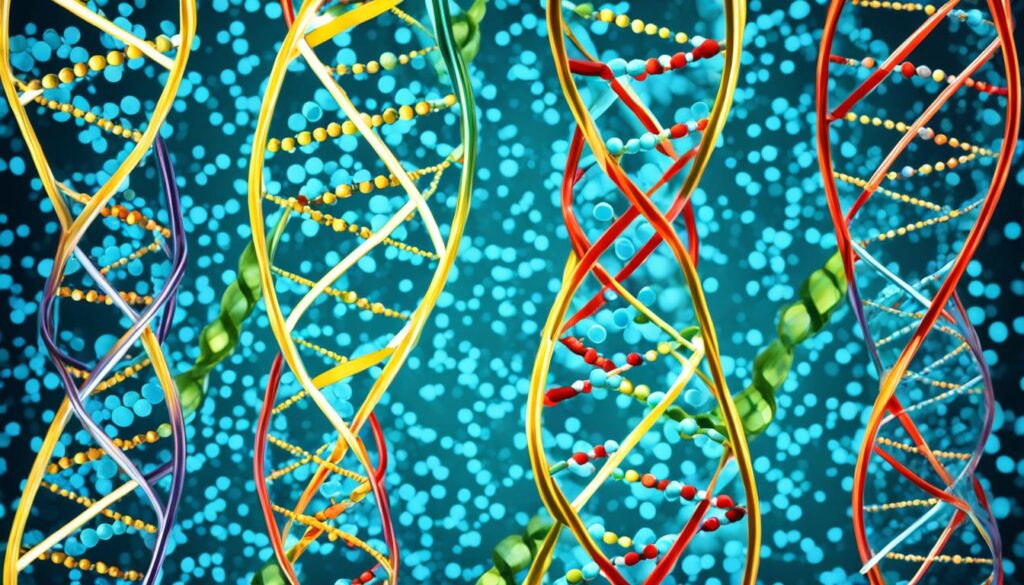Have you ever met someone who seemed too focused on themselves, always wanting attention? That might have been a narcissist. Narcissistic personality disorder (NPD) is a complex issue that has puzzled experts for a long time. The debate on whether narcissists are born or made is ongoing, with researchers looking into its roots.
Looking into narcissism reveals a mix of genetic factors, environmental effects, and life events that shape these traits. Knowing where NPD comes from is key for those affected and society. By understanding what leads to narcissistic behaviors, we can find ways to prevent, intervene early, and treat it effectively.
Let’s explore the complex issue of narcissism together. We’ll look at genetic studies, childhood experiences, and social factors to understand narcissistic personality disorder better. This will help us answer the big question: Are narcissists born or made?
Key Takeaways
- Narcissistic personality disorder is a complex condition with ongoing debates about its origins
- The question of whether narcissists are born or made involves exploring genetic predispositions and environmental factors
- Understanding narcissism causation is crucial for prevention, early intervention, and effective treatment strategies
- Evidence from genetic studies, childhood experiences, and social influences contribute to the etiology of narcissism
- Exploring the origins of narcissistic personality disorder provides valuable insights into this complex personality trait
Understanding Narcissism: Definition and Traits
Narcissism is a complex trait marked by an inflated self-image and a need for lots of attention. People with narcissistic traits often act grandiose, thinking they’re better than others and should get special treatment. This trait can be mild or severe, sometimes reaching the level of narcissistic personality disorder (NPD).
Some common traits include:
- Grandiosity and an exaggerated sense of self-importance
- Preoccupation with fantasies of unlimited success, power, or beauty
- A belief that they are “special” and unique and can only be understood by other special or high-status people
- A constant need for admiration and validation
- A sense of entitlement and expectation of special treatment
- Exploitative behavior, taking advantage of others to achieve their own ends
- Lack of empathy and unwillingness to recognize the feelings and needs of others
- Envy of others and a belief that others are envious of them
- Arrogant and haughty behaviors or attitudes
Narcissistic behaviours can deeply affect relationships and social interactions. They often find it hard to keep healthy relationships because they lack empathy and need constant admiration. They might get angry or show contempt if they don’t get the attention they think they should.
Not everyone with narcissistic traits has narcissistic personality disorder (NPD). Here’s a table that shows the differences:
| Narcissistic Traits | Narcissistic Personality Disorder (NPD) |
|---|---|
| Mild to moderate in severity | Severe and pervasive pattern of behavior |
| May not significantly impair functioning | Causes significant distress or impairment in various areas of life |
| Can be managed or moderated with self-awareness and effort | Requires professional intervention and treatment |
| Traits may be adaptive in certain contexts (e.g., leadership roles) | Maladaptive and destructive in most contexts |
Knowing what narcissism is and its traits help us spot problematic behaviours. This awareness lets us seek help when needed. By understanding narcissistic behaviors, we can aim for healthier relationships and more empathetic interactions.
The Nature vs Nurture Debate in Narcissism
For a long time, experts have debated whether narcissism comes from nature or nurture. They want to know how much genes and environment affect narcissistic traits and behaviors.
Genetic Predispositions to Narcissistic Traits
Research says genes are big in the making of narcissistic personality disorder (NPD) and traits. Twin studies show that narcissism runs in families. About 50-60% of narcissistic traits come from genes, showing a strong genetic link.
Also, certain genes might make someone more likely to be narcissistic. For example, genes related to serotonin and dopamine can increase narcissism. These genes can mix with the environment to shape narcissistic behaviors.
Environmental Factors Shaping Narcissistic Behaviors
Even though genes matter, the environment also plays a big part. Parenting, childhood events, and society can shape narcissistic traits.
Some parenting styles, like too much praise or not setting clear rules, can lead to narcissism. Kids might feel they’re special and better than others. Neglect or trauma can also make someone act narcissistic as a way to cope.
“Narcissism is not simply a product of genes or upbringing alone, but rather a complex interplay between nature and nurture.” – Dr. Sarah Johnson, Psychologist
Culture and society also affect narcissism. In cultures that value self-promotion, narcissistic traits might be seen as positive. Social media, which encourages sharing and seeking attention, can make narcissism more common in young people.
In the end, the debate shows that narcissism comes from both genes and the environment. While genes play a big part, parenting and society also matter. Knowing this helps us find better ways to help people with narcissistic personality disorder.
Are Narcissists Born or Made? Examining the Evidence
Is it true that narcissists are born or made? This debate has been going on among experts. Some think narcissistic traits come from genes, while others believe it’s all about what happens around us. Let’s look at the facts to understand where narcissistic behaviors come from.
Research points to genetics in narcissistic traits. Twin studies show identical twins often share these traits more than fraternal twins, hinting at a genetic link. Certain genes might also make someone more likely to be narcissistic.
But, don’t forget about the impact of the environment. How we were raised, especially by our parents, can shape our narcissism. Kids who get too much praise or lack clear rules might grow up more narcissistic.
“Narcissism is a complex personality trait that is likely influenced by a combination of genetic, environmental, and developmental factors.” – Dr. Susan Krauss Whitbourne, Professor Emerita of Psychological and Brain Sciences at the University of Massachusetts Amherst
Studies that follow people from childhood to adulthood show both nature and nurture at work. This means genetics and upbringing both play a part in how narcissism develops.
- A study by Luo, Cai, and Song (2014) found that both genetic and environmental factors were key in developing narcissistic traits in Chinese twins.
- Brummelman et al. (2015) looked at how parenting affects narcissism. They found that too much praise and not enough warmth can lead to more narcissism in kids.
It seems both nature and nurture play a role in narcissism, but how much each affects someone can differ. Some might be more likely to be narcissistic because of their genes. Others might develop it more because of their environment.
In the end, the science says narcissists are both born and made. Genes and environment together shape narcissistic traits. Knowing this helps us find better ways to help people with narcissistic personality disorder.
The Role of Genetics in Narcissistic Personality Disorder
Environmental factors are key in developing narcissistic personality disorder (NPD). But, genetics also play a big part. Research shows certain genes and family traits make some people more likely to have narcissistic traits. This mix of nature and nurture helps explain how NPD develops.

Heritability Studies on Narcissistic Traits
Studies look into how much narcissistic traits are passed down through families. They compare identical twins and fraternal twins to see what traits they share. This helps figure out how much genetics affects narcissism.
A study by Luo, Cai, and Sedikides (2016) examined two key aspects of narcissism: grandiosity and entitlement. They studied 304 twin pairs and found that genetics play a big role. About 35% of these traits come from genes.
| Study | Sample Size | Heritability Estimate |
|---|---|---|
| Luo, Cai, and Sedikides (2016) | 304 twin pairs | 35% |
| Vernon et al. (2008) | 483 twin pairs | 59% |
| Kendler et al. (2008) | 1,426 twin pairs | 54% |
Genetic Markers Associated with Narcissism
Researchers also look at specific genes linked to narcissism. The oxytocin receptor gene (OXTR) is one area of study. Oxytocin helps with social bonding and trust.
A study by Konrath et al. (2014) found a link between a certain OXTR gene variant and narcissism. This suggests genes like OXTR might affect narcissistic traits. But, more research is needed to understand this fully.
While genes matter in narcissistic traits, they don’t decide if someone will have narcissistic personality disorder. Things like parenting and life experiences also play a big part in NPD.
Childhood Experiences and the Development of Narcissism
Genetics can influence narcissistic traits, but childhood experiences also play a big role. The family and parenting styles an individual grows up with can shape their personality. These early experiences can either help or hinder the growth of narcissistic traits.
Parenting Styles and Narcissistic Traits in Children
Research links certain parenting styles to narcissistic traits in kids. Excessive praise, overindulgence, and not setting clear rules can lead to narcissism. Kids praised too much without feedback might think they’re more important than they are.
On the flip side, neglect or constant criticism can also cause narcissism. Kids feeling ignored or always criticized might build up a big ego to feel better. Not getting enough love or understanding can make it hard for them to manage their feelings and connect with others.
Trauma, Abuse, and Narcissistic Behaviors
Trauma, especially abuse, can deeply affect a child’s development, leading to narcissism. Kids facing abuse might act narcissistic to protect themselves. They may feel the need to control and show off to avoid more harm.
Chronic trauma can mess with how kids develop self-control and handle emotions. Those who’ve been abused might have trouble with impulses, emotions, and forming good relationships. This can lead to narcissistic traits as a way to deal with past trauma.
“Narcissism can be seen as a defense mechanism that develops in response to early experiences of shame, humiliation, or abuse. It serves as a protective shield against the pain of vulnerability and the fear of being exposed as inadequate or unlovable.” – Dr. Lisa Firestone, Clinical Psychologist
Not all kids who go through tough times or bad parenting turn into narcissists. It’s a mix of genes, resilience, and environment that decides if someone will develop narcissistic traits. Knowing how childhood affects personality can help us understand narcissism better and guide therapy.
The Influence of Social and Cultural Factors on Narcissism
Genes and early life experiences are big parts of why some people become narcissistic. But we can’t ignore the big picture of society and culture. Social media and the way we celebrate being unique play a big role in narcissism today.
Culture shapes what we see as success and self-worth. In some places, being all about yourself is seen as good. This can make narcissistic traits more common. Things like personal branding and chasing fame can make it easier for narcissism to grow.

Celebrities and the media have made narcissistic traits more normal. Seeing lots of wealth and success can make people feel they deserve more. Social media is a place where people often show off to get likes and followers.
“In a culture that increasingly values self-promotion and individualism, it is not surprising that narcissistic traits have become more prevalent. The challenge lies in finding a balance between healthy self-esteem and unhealthy self-absorption.”
Young people today, like millennials and Gen Z, might be more likely to be narcissistic. This is because they’re on social media a lot and live in a society that values being unique.
- Social media usage and its correlation with narcissistic behaviors
- Cultural values of individualism and self-promotion
- The influence of celebrity culture on narcissistic tendencies
- Generational differences in narcissistic traits
| Social Influence | Impact on Narcissism |
|---|---|
| Social Media | Increased self-promotion and need for validation |
| Celebrity Culture | Glorification of fame, wealth, and status |
| Individualistic Values | Emphasis on personal achievement and self-enhancement |
| Competitive Environment | Pressure to stand out and be recognized |
Social and cultural factors don’t directly cause narcissistic personality disorder. But they can make it worse. Knowing how genes and the environment work together is key to understanding narcissism. This helps us deal with its effects on our mental health and how we connect with others.
Narcissism Across the Lifespan: How Traits Evolve
Narcissistic traits change as people grow older, especially in their teens, early twenties, and later years. It’s key to see how these traits change to spot and deal with narcissistic behaviors.
Narcissistic Traits in Adolescence and Young Adulthood
Teens and young adults are figuring out who they are and what they want. They might focus more on themselves and want lots of praise, which could seem like narcissism. But it’s important to tell normal growth from real narcissism.
Research says narcissistic traits are usually highest in late teens and early twenties. They often get less intense as people get older and gain more life experience. This shows that some narcissistic actions might just be part of growing up, as people try to find their identity and their spot in the world.
“Narcissism across the lifespan is a complex phenomenon, influenced by a combination of individual experiences, social interactions, and cultural factors.” – Dr. Emily Thompson, Psychology Today
Changes in Narcissistic Behaviors with Age
As people get older, narcissistic traits can change and show up in different ways. Some people might become less narcissistic as they grow and understand themselves better. Others might keep showing these traits throughout their lives.
Studies point out a few things that can change narcissistic behaviors over time:
- Increased self-reflection and introspection
- Life experiences that challenge one’s sense of superiority
- Developing empathy and considering others’ perspectives
- Engaging in therapy or personal growth work
But, people with narcissistic personality disorder (NPD) often keep showing strong narcissistic traits. These traits are unlikely to change much without help and support.
| Life Stage | Common Narcissistic Traits |
|---|---|
| Adolescence | Heightened self-focus, desire for admiration, sense of invincibility |
| Young Adulthood | Grandiosity, entitlement, exploitative behaviors, lack of empathy |
| Middle Adulthood | Decreased grandiosity, increased self-awareness, potential for growth |
| Late Adulthood | Possible reduction in narcissistic behaviors, greater life perspective |
Knowing how narcissistic traits change over time helps us spot and deal with bad behaviors. By seeing the chance for change and growth, people can work on better self-concepts and relationships as they age.
The Interplay of Nature and Nurture in Narcissism Causation
The growth of narcissistic personality disorder is complex, blending genetic predispositions with environmental factors. The debate between nature and nurture has long been ongoing in psychology. Now, research shows both play a big part in forming narcissistic traits. Epigenetics links innate tendencies with learned behaviors, offering a deeper look into narcissism’s roots.
Epigenetic Factors in Narcissistic Personality Disorder
Epigenetics looks at how the environment changes gene expression without changing DNA. In narcissism, epigenetics might show how life events, like childhood trauma or too much praise, can turn on or off genes linked to narcissism. For example, a child prone to narcissism might feel more important if always praised. But, a caring environment could reduce narcissistic traits, even in those likely to have them.
Gene-Environment Interactions and Narcissism
Gene-environment interactions show how nature and nurture work together in narcissism. Some genes make people more open to environmental effects, good or bad. A certain gene might make someone more sensitive to criticism or neglect, leading to more narcissistic behaviors. Yet, a supportive environment can lessen these effects, helping people develop better personalities. Knowing about these interactions is key to helping those at risk of narcissistic personality disorder.
FAQ
Are narcissists born or made?
The roots of narcissistic personality disorder are deep and complex. They blend genetic predispositions with environmental factors. While some may naturally lean towards narcissistic traits, life events, parenting, and social surroundings shape their behaviors.
What are the key traits of narcissistic personality disorder?
This disorder is marked by grandiosity, a need for admiration, and a lack of empathy. People with it also feel entitled and focus on power and success. They often see themselves as superior and use manipulation to keep up their image.
How do genetic factors contribute to narcissism?
Research points to a genetic link in narcissistic personality disorder. Specific genes linked to narcissistic traits have been found, and studies show it can run in families. Yet, genes aren’t the only factor; environment also plays a big part.
What childhood experiences can lead to the development of narcissistic traits?
Overindulgent parenting, lack of boundaries, or emotional neglect can shape narcissistic traits. Childhood trauma or abuse might also lead to narcissistic behaviors as a way to cope. But not everyone with these experiences will develop narcissistic disorder.
Can narcissistic traits change over time?
Yes, narcissistic traits can change and show up differently at different ages. They might be more obvious in the young and less so as people get older. Personal growth, self-awareness, and life events can change how narcissistic traits are shown.
How do social and cultural factors influence narcissism?
Social and cultural norms can shape narcissistic attitudes and actions. Societies that value individualism and competition can lead to more narcissistic traits. The media and social media also play a part by promoting self-centeredness and seeking external validation.
What is the role of epigenetics in narcissism causation?
Epigenetics looks at how environment affects gene expression without changing DNA. It might play a part in narcissistic personality disorder by turning genes on or off based on experiences. The complex relationship between genes and environment is still being studied for its role in narcissism.







